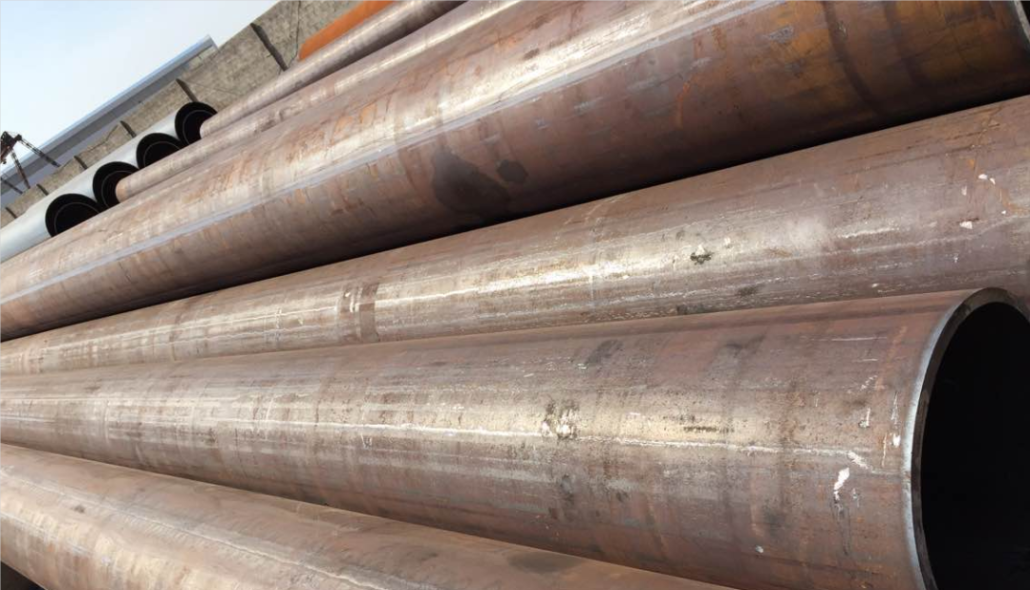Forming Process Of Straight Seam Welded Steel Pipe
In terms of welding technology, straight seam steel pipes can be divided into resistance welded straight seam steel pipes and submerged arc welding straight seam steel pipes. Resistance welded straight seam steel pipes are further divided into high frequency welded straight seam steel pipes, medium frequency welded straight seam steel pipes, and low frequency welded straight seam steel pipes. The submerged arc welded straight seam steel pipe is also called double-sided submerged arc welded straight seam steel pipe or LSAW straight seam steel pipe, where LSAW is (the abbreviation of Longitudinally Submerged Arc Welding is LSAW).
Electric resistance welded straight seam steel pipe is also called ERW straight seam steel pipe. ERW is (Electric Resistance Weldin), and the abbreviation is ERW. High frequency welded straight seam steel pipe is also called ERW straight seam steel pipe. ERW is a general term for resistance welded steel pipes. Straight seam high-frequency resistance welding pipe (Electric Resistance Welding, referred to as ERW) ERW is the first letter of the corresponding English word.
Resistance welded steel pipes are divided into two forms: AC welded steel pipes and DC welded steel pipes. AC welding is divided into low frequency welding, medium frequency welding, super medium frequency welding and high frequency welding according to the frequency. High-frequency welding is mainly used for the production of thin-walled steel pipes or ordinary-walled steel pipes. High-frequency welding is divided into contact welding and induction welding. DC welding is generally used for small diameter steel pipes.
The main steps are as follows:
1. Plate detection: After the steel plates used to manufacture large-diameter submerged arc welded straight seam steel pipes enter the production line, they are first subjected to full-plate ultrasonic inspection;
2. Edge milling: Use an edge milling machine to perform double-sided milling on both edges of the steel plate to achieve the required plate width, plate edge parallelism and bevel shape;
3. Pre-bending edge: Use a pre-bending machine to pre-bend the edge of the board so that the edge of the board has a curvature that meets the requirements;
4. Forming: On the JCO forming machine, first half of the pre-bent steel plate is stamped into a “J” shape through multiple steps, and then the other half of the steel plate is similarly bent into a “C” shape, and finally the opening is formed. “O” shape
5. Pre-welding: join the formed straight seam welded steel pipes and use gas shielded welding (MAG) for continuous welding;
6. Internal welding: Use longitudinal multi-wire submerged arc welding (up to four wires) to weld the inside of the straight seam steel pipe;
7. External welding: tandem multi-wire submerged arc welding is used to weld the outside of the longitudinal submerged arc welded steel pipe;
8. Ultrasonic inspection I: 100% inspection of the internal and external welds of the straight seam welded steel pipe and the base metal on both sides of the weld;
9. X-ray inspection I: 100% X-ray industrial television inspection of internal and external welds, using an image processing system to ensure the sensitivity of flaw detection;
10. Diameter expansion: The entire length of the submerged arc welded straight seam steel pipe is expanded to improve the dimensional accuracy of the steel pipe and improve the distribution of stress within the steel pipe;
11. Hydraulic pressure test: The expanded steel pipes are inspected one by one on a hydraulic pressure testing machine to ensure that the steel pipes meet the test pressure required by the standard. The machine has automatic recording and storage functions;
12. Chamfering: Process the pipe end of the steel pipe that has passed the inspection to achieve the required pipe end bevel size;
13. Ultrasonic inspection II: Conduct ultrasonic inspection one by one again to check for defects that may occur after diameter expansion and hydraulic pressure of the straight seam welded steel pipes;
14. X-ray inspection II: X-ray industrial television inspection and pipe end weld photography on the steel pipe after diameter expansion and hydraulic pressure test;
15. Magnetic particle inspection of pipe ends: This inspection is performed to detect pipe end defects;
16. Anti-corrosion and coating: Qualified steel pipes will be anti-corrosion and coated according to user requirements.


اترك رداً
تريد المشاركة في هذا النقاششارك إن أردت
Feel free to contribute!